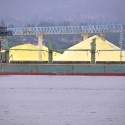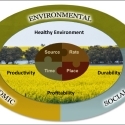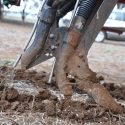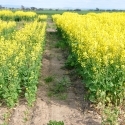10 Aug 2017
Split germinations and nutrition
Some issues to consider
 Poor emergence of canola in the Wimmera
Poor emergence of canola in the Wimmera
In seasons with an early break followed by low rainfall, staggered germination of the crop can become a problem. There may be better germination on lighter soils where water infiltration is more rapid than on heavier soils, and on both the use of press wheels can also assist in improving germination.
However – the issue remains – what to do with a crop that is uneven and shows variation in crop and weed growth stages. It is very rare that resowing the crop will pay off as late sowing means the crop will grow slowly in a shorter winter, and then grain filling may be compromised by heat stress. Most of the modelling and experience with late sown or re-sown crops suggests only poor yields are likely, even with a good finish. The exception here is where there is concern about leaving the soil bare over summer – and thin or late sown crop can provide some protection.
There are a couple of in-crop management aspects to consider here:
1. What is the realistic yield potential – is there adequate soil water to meet that potential and is the seasonal forecast kind enough to provide confidence that the potential will be met.
2. The need for fertilizer N depends on the yield potential – and a 1.5 t/ha wheat crop only requires around 60 kg N/ha. This may be met by mineralisation pre-crop and in-crop.
3. Even if the crop yield potential warrants additional N, the distribution of the poor, average and good areas in the paddock may make this impractical. If there are “good” patches – assessed by eye or with NDVI sensors (remote or proximal) – there may be the opportunity to top-dress N onto those patches.
4. It is important to protect that yield potential and timing of herbicide application also becomes difficult. Deal with N nutrition first though – as N deficient weeds are harder to kill.
5. If there are no defined areas at different growth stages, time herbicide applications to the most common stage, and slightly earlier is probably better than too late. There are other issues with herbicide use including minimizing grass weeds escape and care with residual herbicides that may carry through to the following year if conditions remain dry. Consult an experienced agronomist to discuss this issue.
In the longer term, poor or failed crops can mean P carryover can occur, so that P rates can be reduced. Where off-take is significantly less than application, and soil tests are at maintenance levels or more, then rates can be reduced, but there is still benefit in providing some P in the seed row to encourage early vigour.
For more information on P carryover - see http://anz.ipni.net/article/ANZ-3223
Acknowledgement - This brief article includes information from respected agronomic consultants Kent Wooding, Mark Stanley, Bill Long, Andy Bates and Mick Faulker.




